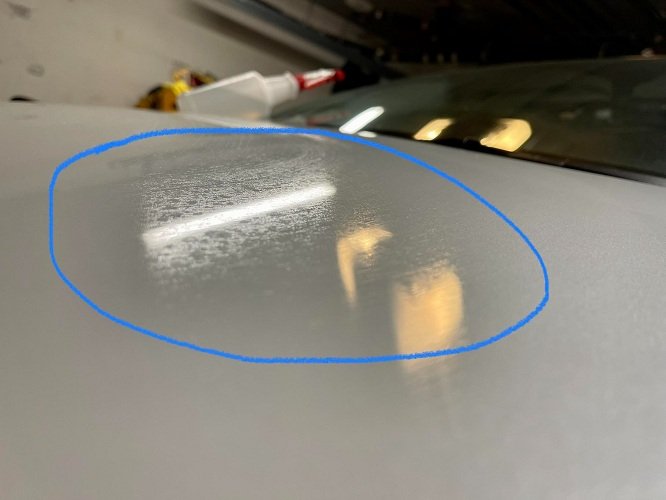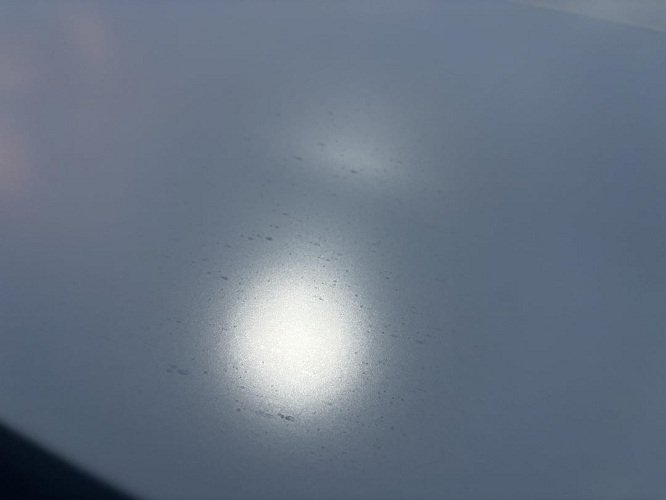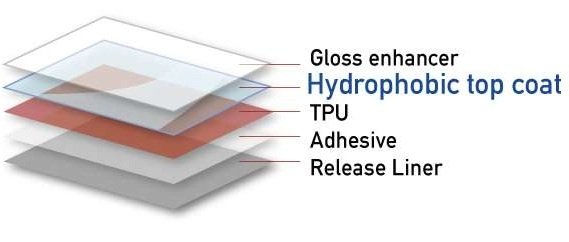- Water spots on STEK PPF
- Why Water Spots Are Bad?
- Remove water spots on matte PPF | Why it is difficult?
- How to get rid of water spots on STEK PPF?
- Are water marks permanent on PPF?
- Ho Chi Minh City | How do you maintain a PPF car?
- How we wash cars after ceramic coating and PPF
- Quan 2 TPHCM | How to remove water spot on PPF?
Water spots on STEK PPF #
If you’ve ever found hard water marks on car PPF, you know how frustrating it can be. These minerals (commonly calcium and magnesium) are especially abundant in “hard water” sources like tap water in places like Ho Chi Minh City.
And even you’ve invested in top-tier protection for your vehicle with STEK paint protection film (PPF) brand, water spots can and will happen. Let’s dive right in.
Why Water Spots Are Bad? #
Water spots are marks left behind when water evaporates. And deposits of minerals—especially calcium, magnesium, and silica will bake onto a surface of the Paint Protection Film (PPF). These hard spots are particularly problematic because they will etch into the film’s topcoat layer.
- Permanent dull spots or discoloration
- Loss of clarity on gloss PPF
- Blotchy appearance on matte or satin PPF
- Reduced self-healing capability
Once these minerals have etched into the topcoat, a regular car wash won’t remove them.


Remove water spots on matte PPF | Why it is difficult? #
On matte or satin finish PPF, water spots are even more dangerous because you can’t polish the surface like you can with gloss finishes.
- Polishing matte PPF would create shiny patches, ruining the uniform satin look.
- Even chemical spot removers must be used carefully to avoid altering the texture or sheen.
For severe etching, replacement of the affected film section is often the only solution.

How to get rid of water spots on STEK PPF? #
STEK Paint Protection Film is known for good self-healing and hydrophobic topcoat. In this guide, we’ll cover how to safely remove water spots etching from your PPF and prevent future damage.
Step 1: Preparing Your Supplies #
Before delving into the meticulous task of cleaning your paint protection film, it’s crucial to have the right tools and materials at your disposal. These will not only help you achieve a thorough cleaning but also ensure that the film remains in top condition without sustaining any damage.
What You Need:
- pH-neutral car wash soap
- Hot water
- PPF water spot remover
- Microfiber towels
- Quick detailer spray
Step 2: Wash Your Vehicle #
Before trying any remover, do this:
- Wash the affected panel with pH-neutral car shampoo and a microfiber mitt.
- Rinse with clean water.
- Dry using a soft microfiber towel to prevent more spots.
- This ensures you’re working on a clean surface and not rubbing in dust or debris.
Why it is important?
Because you don’t want to clean these stains and cause damaging the PPF. This makes no sense. And, washing your car can help you identify the water marks properly.
If spots are light but stubborn:
- Use a fine-grade clay bar or clay mitt with a high-quality clay lubricant.
- Gently glide over the affected area.
We don’t recommend this clay bar for matte or satin PPF, as claying may leave shiny patches or alter the texture.
Step 3: Activate the PPF’s Self-Healing Properties with Hot Water #
When STEK DynoShield is installed on your car, you can apply heat on the top coat layer. Why?
Because it can help eliminate minor etching. Often, the PPF’s self-healing properties will reduce or eliminate the etching. If heat doesn’t fully remove the damage, move on to the next step.
How to apply Heat:
- Use a diluted isopropyl alcohol to remove any remaining contaminants.
- Wipe away the debris carefully.
- Dry the area with a clean microfiber towel.
- Pour hot water (not boiling water) over the etched area.
We recommend using 60 °C – 70 °C hot water to activate this feature instead of using a heat gun.
Step 4: Using a Dedicated Water Spot Remover #
Yes, we recommend using the best PPF water spot remover you have. These chemical are designed to break down the hard mineral deposits safely on your vehicle. How to use:
- Spray or apply the remover to a microfiber towel (not directly onto the panel).
- Gently wipe the affected area.
- Let dwell for a short time (10–20 seconds).
- Buff off with a clean, dry microfiber.
- Rinse the panel with water and dry again.
Quick Tip:
Always test on a small, inconspicuous area first, especially if you’re dealing with any PPF. Different version features, batch qualities and how long it’s been used may be different between every film.
Step 5: Apply a PPF-Safe Sealant #
Once the etching is removed, it’s a good idea to apply a PPF sealant to prevent future damage.
Why?
- Over time, unaddressed water spots can weaken the film’s hydrophobic properties
- Damaged PPF can continue to promote oxidation and UV damage in the topcoat
- Because the best paint sealants will help maintain the film’s hydrophobic properties and keep your car clean.
For DIY users, we recommend CARPRO ELIXIR.
Are water marks permanent on PPF? #
If the water spots are deeply etched and don’t respond to any of the above methods:
- Consider contacting a professional detailer experienced with PPF.
- In extreme cases, especially on satin/matte films, the only option may be to replace the affected section of PPF.
Ho Chi Minh City | How do you maintain a PPF car? #
In tropical or urban areas like Ho Chi Minh City, the risk is higher because of:
- High mineral content in tap water
- Frequent rain with acidic pH
- Strong sun exposure, which bakes minerals into the film
But you can maintain STEK Paint Protection Film with 5 easy tips:
- TIP 1: Use deionized (DI) water for rinsing: because tap water in Ho Chi Minh City often contains high levels of minerals—calcium, magnesium, iron, and other Total Dissolved Solids (TDS). When you rinse a car with this water, mineral particles remain suspended in the droplets that cling to the PPF.
- TIP 2: Dry immediately with a microfiber towel after washing or rain: Quality microfiber towels will lean all the remaining moisture on the car. It will keep your car out of dirt and debris.
- TIP 3: Avoid washing in direct sunlight: because Ho Chi Minh City is located in a tropical climate zone, with high UV index and strong sunlight year-round.
- TIP 4: Apply a ceramic coating designed for PPF to provide a hydrophobic, protective top layer: The best ceramic coating for PPF will enhance water repellence and reduces water dwell time on the film. So it will lower the chance for spotting.
- TIP 5: Maintain a regular wash schedule—don’t let water or dust sit on the film for too long: a car detailing wash will kick out all the dirt and debris safely. And it will keep your PPF clean.
Quick Tip:
What to do if you get rain right after a car wash?
- Rinse with distilled water if available.
- Dry quickly, especially horizontal panels (roof, hood, trunk).
- Apply a quick detailer spray with light lubricants to reduce residue.
How we wash cars after ceramic coating and PPF #
Quan 2 TPHCM | How to remove water spot on PPF? #
Yes, we can check and remove water spots on PPF safely. Just drop us a message via WhatsApp or fill in this form. We will contact you shortly.
Our shop is located at 18 đường số 19, Phường An Phú, TP. Thủ Đức, TP. Hồ Chí Minh. We open all days 7:30am – 5:30pm.
Disclaimer
These blogs are meant purely for education and demonstration purposes. It contains only general information and may not account for specific issues related to your particular vehicle or situation. All content provided on this blog is for informational purposes only. The owner of this blog makes no representations as to the accuracy or completeness of any information on this site or found by following any link on this site.
No warranties
THIS WEBSITE IS PROVIDED “AS IS” WITHOUT ANY REPRESENTATIONS OR WARRANTIES, EXPRESS OR IMPLIED INCLUDING, BUT NOT LIMITED TO, WARRANTIES OF TITLE OR IMPLIED WARRANTIES OF MERCHANTABILITY OR FITNESS FOR A PARTICULAR PURPOSE. COMPANY MAKES NO REPRESENTATIONS OR WARRANTIES IN RELATION TO THIS WEBSITE OR THE INFORMATION AND MATERIALS ON THIS WEBSITE. WITHOUT PREJUDICE TO THE GENERALITY OF THE FOREGOING PARAGRAPH, COMPANY DOES NOT WARRANT THAT THIS WEBSITE WILL BE CONSTANTLY AVAILABLE, OR AVAILABLE AT ALL; OR THE INFORMATION ON THIS WEBSITE IS TRUE, COMPLETE, ACCURATE OR NON-MISLEADING. NOTHING ON THIS WEBSITE OR IN THE BLOG CONSTITUTES OR IS MEANT TO CONSTITUTE ADVICE OF ANY KIND.
Limitations of liability
IN NO EVENT SHALL THE COMPANY BE LIABLE TO CLIENT FOR ANY DIRECT, INDIRECT, INCIDENTAL, SPECIAL, PUNITIVE, OR CONSEQUENTIAL DAMAGES OR FOR ANY BUSINESS LOSSES, LOSS OF REVENUE, INCOME, PROFITS OR ANTICIPATED SAVINGS, LOSS OF CONTRACTS OR BUSINESS RELATIONSHIPS, LOSS OF REPUTATION OR GOODWILL, OR LOSS OR CORRUPTION OF DATA WHATSOEVER RESULTING FROM ANY ACT OR OMISSION RELATING TO THE SERVICES.
These blogs provide information about past occurrences with vehicles. This may not allow for a proper diagnosis in all instances. Your particular issue may contain unknown factors that would affect the outcome of following the information found in the blog. The blog is not a substitute for advice from a trained professional. You should always seek the advice of the automobile manufacturer, the dealer where the automobile may have been purchased, a qualified mechanic or other qualified professional with any questions you may have regarding automobile safety, maintenance, or repair. You should not delay, avoid or disregard the advice of the manufacturer, dealer or qualified auto mechanic because of anything you may have read, seen or heard in these blogs.




